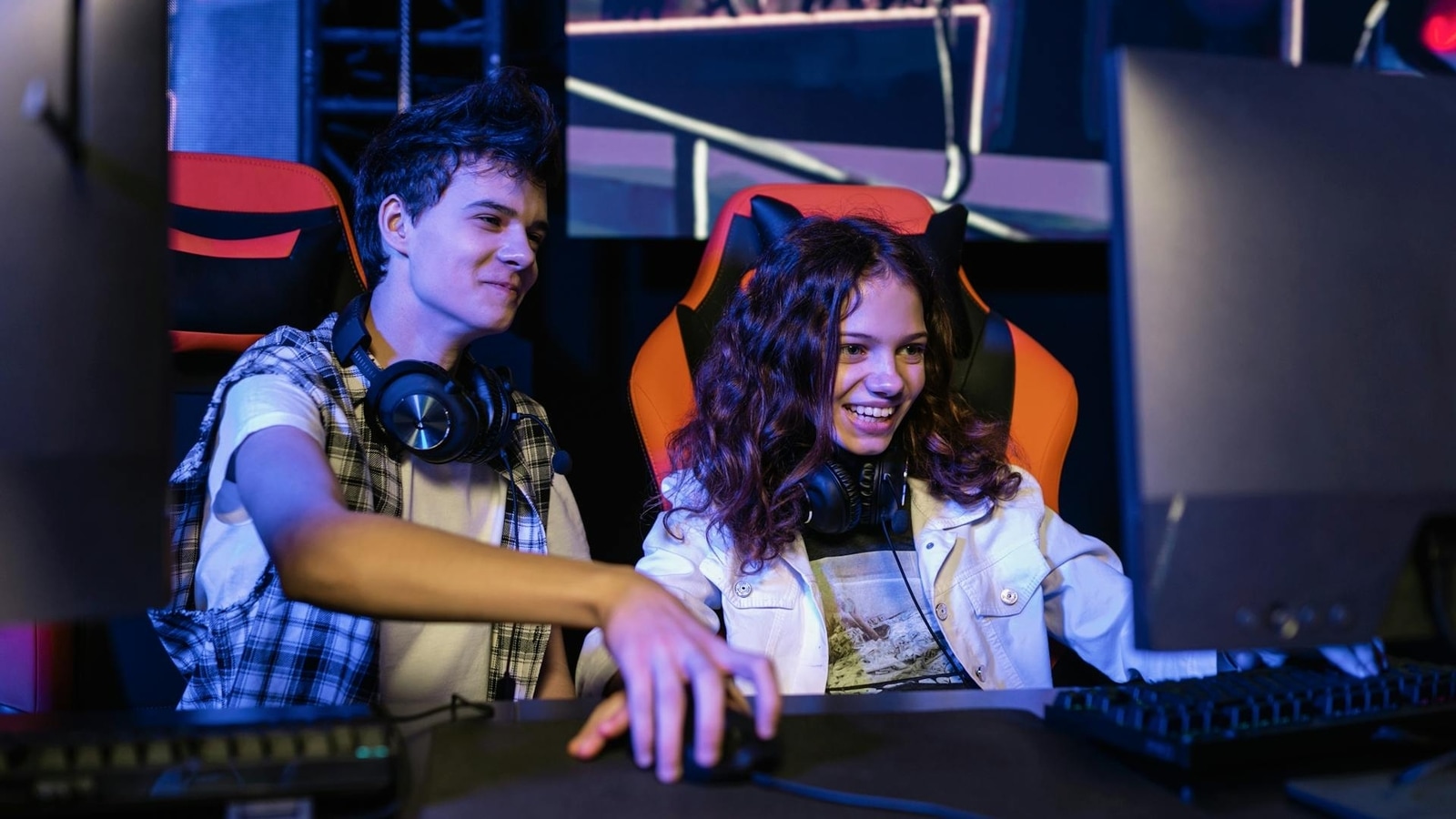Verdict
The Samsung Galaxy Book 3 Ultra is the best Windows attempt I’ve seen yet at displacing the MacBook Pro. The design, performance and battery life don’t quite meet Apple’s high bar, but a portable frame nevertheless makes this a great option for on-the-go creativity.
Pros
- Powerful enough for content creation
- Professional-grade screen
- Portable enough for on-the-go work
- Comparatively good battery life
Cons
- Expensive
- Subpar speakers
- Rivals offer better graphics performance
-
Powerful graphics performance:The options of an Nvidia RTX 4050 and RTX 4070 allow for a powerful graphics performance. -
120Hz OLED display:The OLED screen ensures highly accurate colours, while the 120Hz refresh rate improves the apperance of fast motion. -
Portable design:Weighing just 1.8kg, this is one of the most portable 16-inch laptops with such specs.
Introduction
I’ve lost count of the number of Windows laptops that confidently took a swing at the MacBook Pro, only to miss its mark and eventually fade away into mediocrity. The Samsung Galaxy Book 3 Ultra is the latest contender.
Samsung is the latest challenger to enter the ring, with the Galaxy Book 3 Ultra doing its very best MacBook Pro impersonation in a bid to win over the creative crowd. It has enough firepower for heavy-duty graphics jobs, a decent number of ports to shun the dongle life, and a lovely 3K display with perfect colour reproduction.
Unfortunately, it’s also picked up a bad habit from the MacBook Pro line, as Samsung is charging a fortune: a base price of £2449/$2199, and up to £3049/$2999.99 if you max out the specs. That means it’s going right up against the 16-inch Macbook Pro which has a starting price of £2699/$2499.
Can the Samsung Galaxy Book 3 Ultra dethrone the MacBook Pro as the go-to laptop for professional creators? I’ve spent several weeks with the laptop to find out, so here are my thoughts.
Design and Keyboard
- Lighter than most other 16-inch laptops
- High quality webcam with AI features
- Recyclable packaging
Take a look at the Samsung Galaxy Book 3 Ultra from a distance, and you’ll likely mistake it for a MacBook Pro – and I’m pretty sure that’s no mistake on Samsung’s part. With the recessed keyboard, slim graphite chassis and unassuming yet stylish design, Samsung is clearly trying to capture the same classy vibe that the MacBook Pro has mastered.
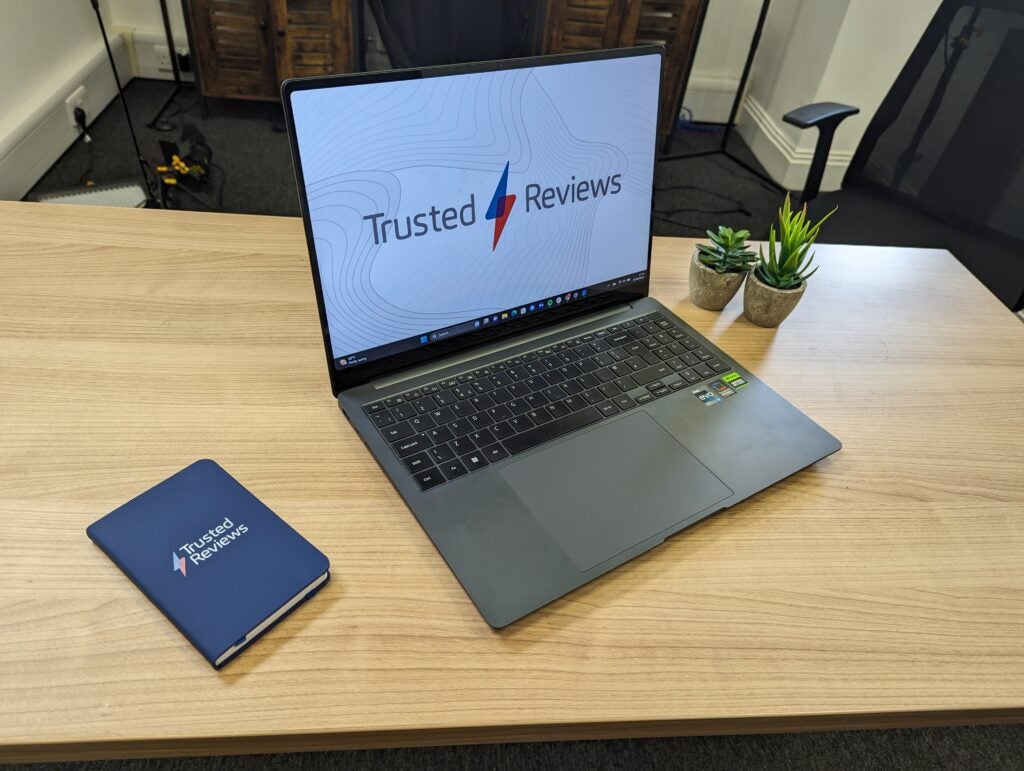
I don’t think the Samsung Galaxy Book 3 Ultra has achieved that goal. It by no means looks bad, but the small Samsung logo on the lid and bland mono-colour scheme cause this laptop to struggle to stand out from other Windows machines – there’s not much personality here. The chucky under-glass bezel at the bottom of the screen looks a tad outdated too.
The Galaxy Book 3 Ultra hits the scales at 1.79kg. I wouldn’t call that lightweight, but it’s just about portable enough for me to happily lug to the office on a daily basis, which is impressive given the 16-inch screen and powerful specs. For context, the basic 16-inch MacBook Pro weighs a stonking 2.15kg, making it 360 grams heavier.
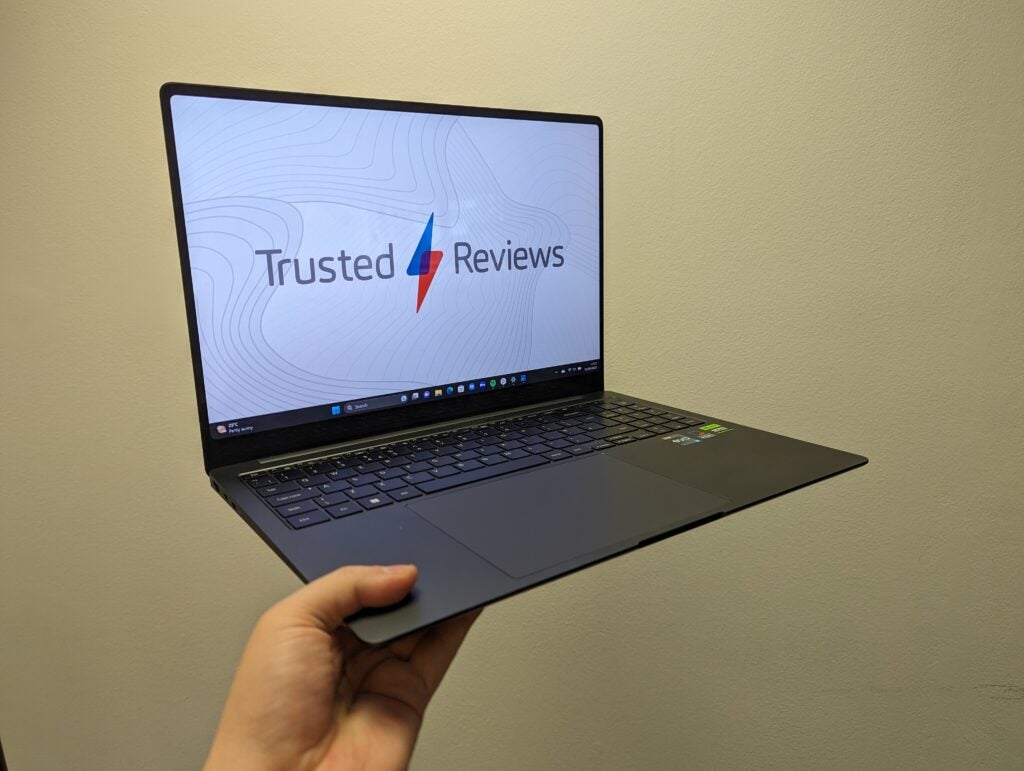
The off-centre trackpad is so big that it takes up half the chassis of the Galaxy Book 3 Ultra. That sounds like it should be a good thing, but the larger size increased the odds of food crumbs or dust sneaking it way onto the surface, causing the touch input to fall out of whack.
The massive trackpad also causes the keyboard to look a little cramped by contrast. That must be an optical illusion though, as the keys are still spaced out well enough for a decent typing experience, albeit with shallow travel which can be uncomfortable on the wrists after long periods.
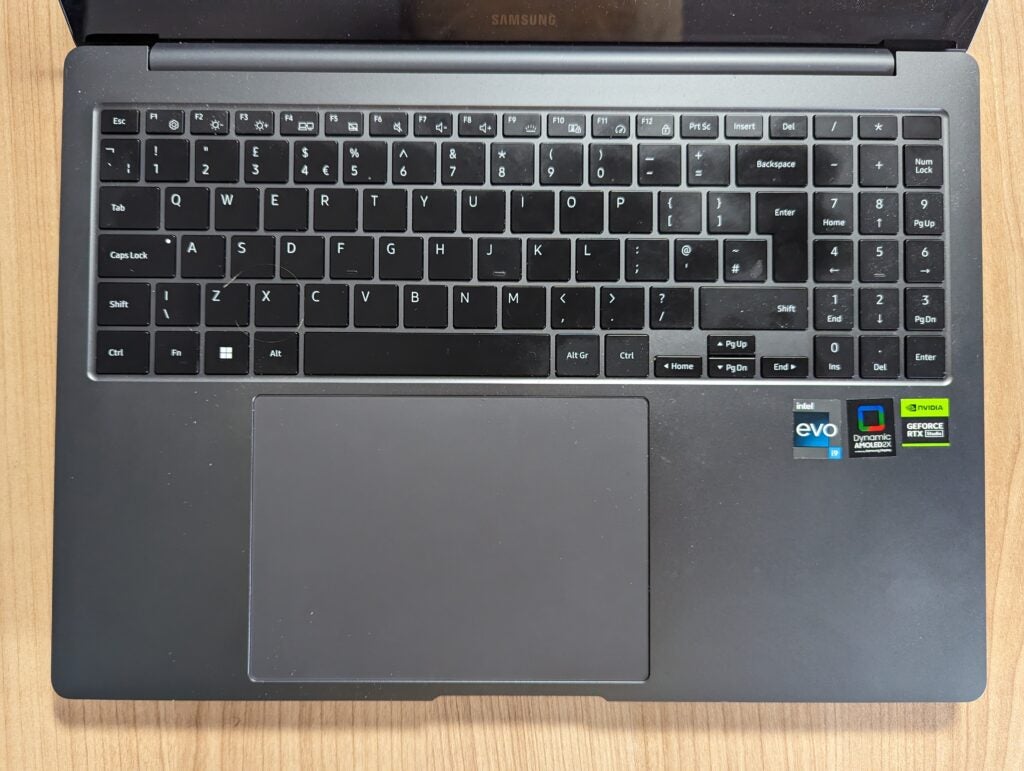
My biggest concern with the keyboard is the lacklustre backlight, even when cranked up to full brightness. I often found it difficult to establish whether the Caps Lock indicator light was switched on or off, while it could also prove an issue for after-dark typing. At least you get a fingerprint sensor built into the power button.
There’s a great quantity of ports here, with 2x USB-C (Thunderbolt 4) and HDMI found on the left side, and Micro SD, USB-A and a headphone jack located on the right. It has a Full HD (1080p) webcam too, which is one of the better ones I’ve tested on a laptop yet, providing detailed and sharp capture of my face during calls.
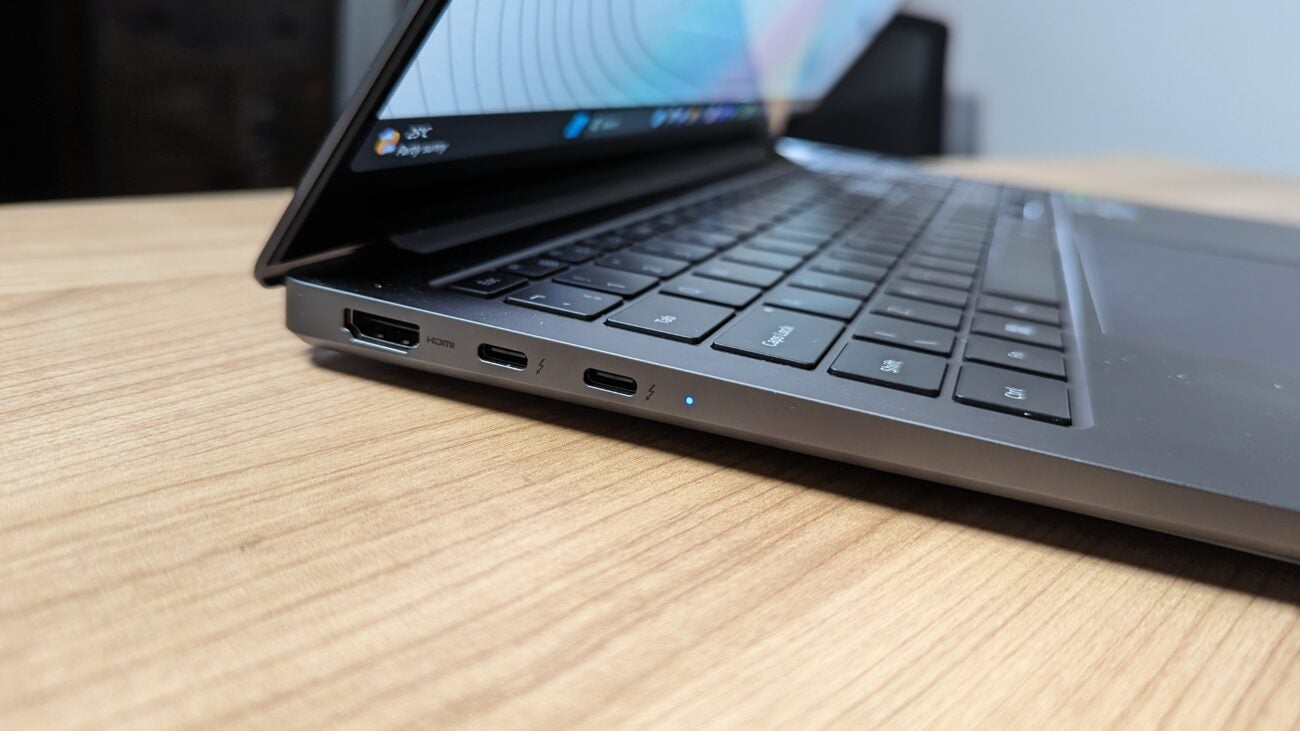
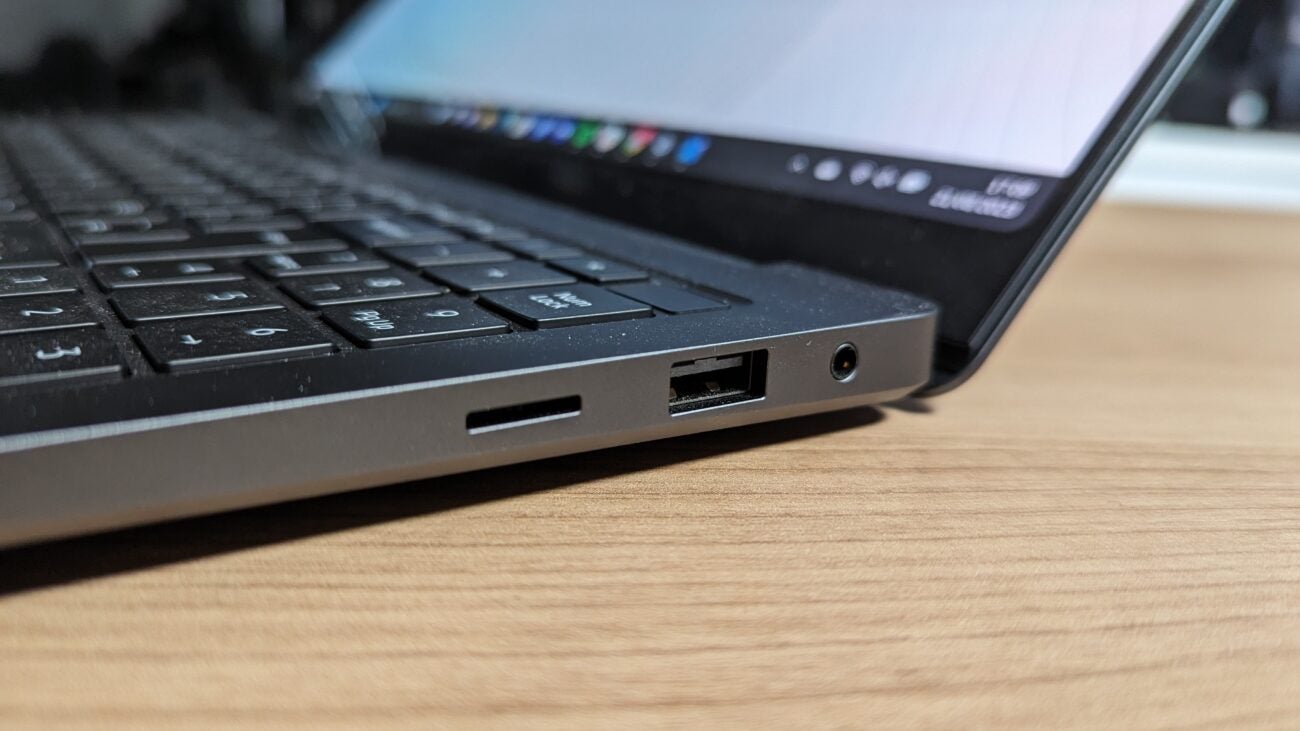
Samsung Galaxy Book 3 Ultra left side ports
Samsung Galaxy Book 3 Ultra right side ports
Samsung also offers a Studio Mode feature that is accessible with whatever camera app you use, whether it’s Zoom, Teams or just the default app in Windows.
Studio Mode allows you to blur your background, track your face to keep you in shot, or even apply a filter over your face to remove the bags under your eyes. It’s useful to have all of these useful features in one place.
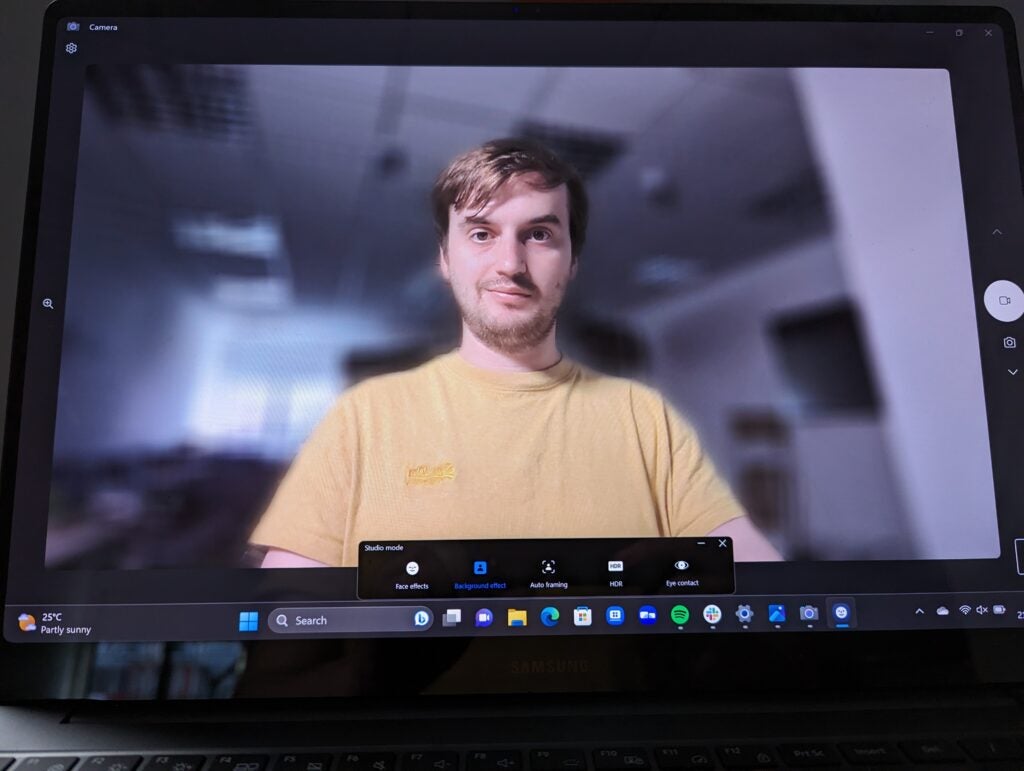
I was really impressed with Samsung’s sustainability efforts for the packaging. The entire box is recyclable, and there aren’t any needless plastic wrappings that many laptop manufacturers are guilty of including.
Samsung has confirmed that parts of the Galaxy Book 3 Ultra are made up of recycled plastics that use ocean-bound discarded fishing nets. It’s a step in the right direction, but this represents a very small portion of the laptop.
Display and Sound
- Large 16-inch screen
- OLED ensures accurate colours
- 120Hz refresh rate included
The screen is one of the most important aspects of the MacBook Pro, as it offers near-perfect colour reproduction to ensure creators can see an accurate representation of the colours for on-screen graphics, photos and videos.
The 16-inch AMOLED panel of the Samsung Galaxy Book 3 Ultra delivers equally good results, with my tests showing it to hit 100% coverage for sRGB and DCI-P3, as well as 99% for Adobe RGB – those are excellent results for creative professionals.

The AMOLED technology also helps to drastically boost the screen’s contrast, capable of inky blacks whereas standard LCD screens may paint shadows and night skies with a subdued grey tint instead.
The downside of OLED is that the brightness can’t be pushed quite as high as that of the Mini LED panel of the MacBook Pro. I recorded a highly respectable 432-nit peak on the Galaxy Book, whereas Apple claims its latest MacBook Pro can hit 500 nits for SDR content.
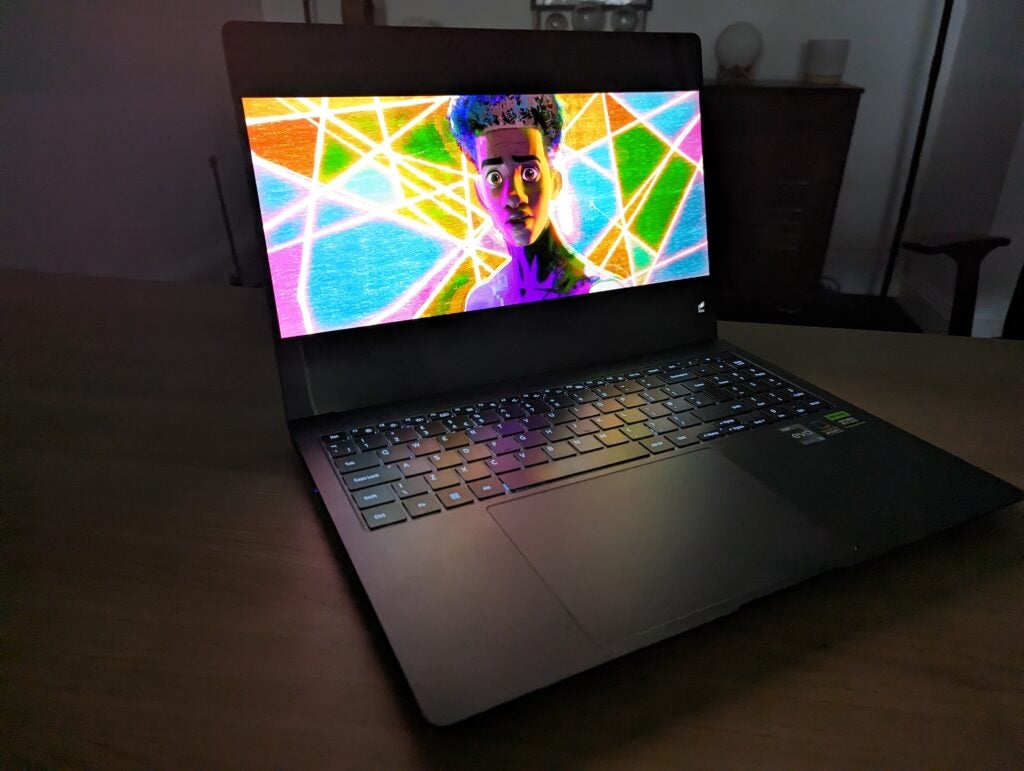
Samsung has ensured its screen packs plenty of detail though, with a 3K (2880×1800) resolution. Images on display look incredibly sharp, while bright colours look so vivid that they’re seemingly poking out of the panel. Samsung has even cranked the refresh rate up to 120Hz, resulting in smooth, fluid motion.
The Samsung Galaxy Book 3 Ultra has a quad-speaker setup, found on the laptop’s rear but angled outwards rather than straight into the desk. Volume can be cranked up to a room-filling decibel, but I wouldn’t recommend doing so, as instrumentals start to sound muffled and strained, while bass sounds hollow and hoarse. Turn down the volume, and the audio quality is just about fine to pump out your Spotify tunes.
Performance
- Professional-grade performance
- Slightly compromised graphics
- Speedy SSD
The Samsung Galaxy Book 3 Ultra is available with a few different configurations. You can choose between i5 and i7 for the 13th Gen Intel Core H-series processors, while for the GPU you have the option of the Nvidia RTX 4050 or RTX 4070.
But how does the performance stack up? Samsung sent me a unit with an Intel Core i9-13900H processor and RTX 4070 pairing, and it offered enough power to glide through day-to-day tasks with ease. It felt like a big jump up from standard productivity laptops such as the Dell XPS 13.
My benchmark results showed the Galaxy Book 3 Ultra to offer a similar performance to the 14-inch MacBook Pro with an M2 Pro processor. Apple stole a lead in the Cinebench R23 test, which is a good indicator for rendering workloads, but only by a minor margin. The processing performance remained competitive with high-powered Windows laptops such as the ZenBook Pro 14 OLED, Vivobook Pro 16X OLED and Razer Blade 16.
The Samsung Galaxy Book 3 Ultra wasn’t quite as competitive when it came to graphics performance. Both the Zenbook Pro 14 OLED and Vivobook Pro 16X OLED stole sizable leads in the 3DMark Time Spy test, despite both using an RTX 4070 GPU too.
Digging into the specs, it looks like Samsung has opted for a 60W TDP (Thermal Design Power) for the RTX 4070 GPU, while Asus has stuck with more powerful 90W TDP iterations. This explains the graphics performance difference, with Samsung seemingly sacrificing a little power for enhanced portability and battery life.
The Galaxy Book 3 Ultra is still a powerful laptop, well equipped for the likes of photo/video editing. I also found it to be capable of playing Cyberpunk 2077 in Full HD with max graphics settings, with an average 30fps performance. Considering this is one of the most demanding PC games you can play, you can expect this laptop to run pretty much any game you fancy.
Thermal performance seems good too. I can’t remember an instance where I noticed the laptop heating up significantly, or the fans whirring up to a level that became distracting.
The SSD performance is strong, with read and write speeds of 6642MB/s and 4991MB/s respectively. This allows for quick transfers to and from the physical drive, as well as instant loading times when gaming.
Software
- Seamless connection to Galaxy phones
- Irksome bloatware for those without Samsung phone
Clearly inspired by Apple, Samsung has put in a big effort to create a more streamlined ecosystem by improving the communication between its smartphones and laptops.
As a result, the Samsung Galaxy Book comes with numerous apps pre-installed that smartly sync up with your Samsung Galaxy phone. For example, the Samsung Flow app allows you to instantly transfer images and videos from your phone to your PC. This did wonders for my workflow, speeding up the process tenfold.
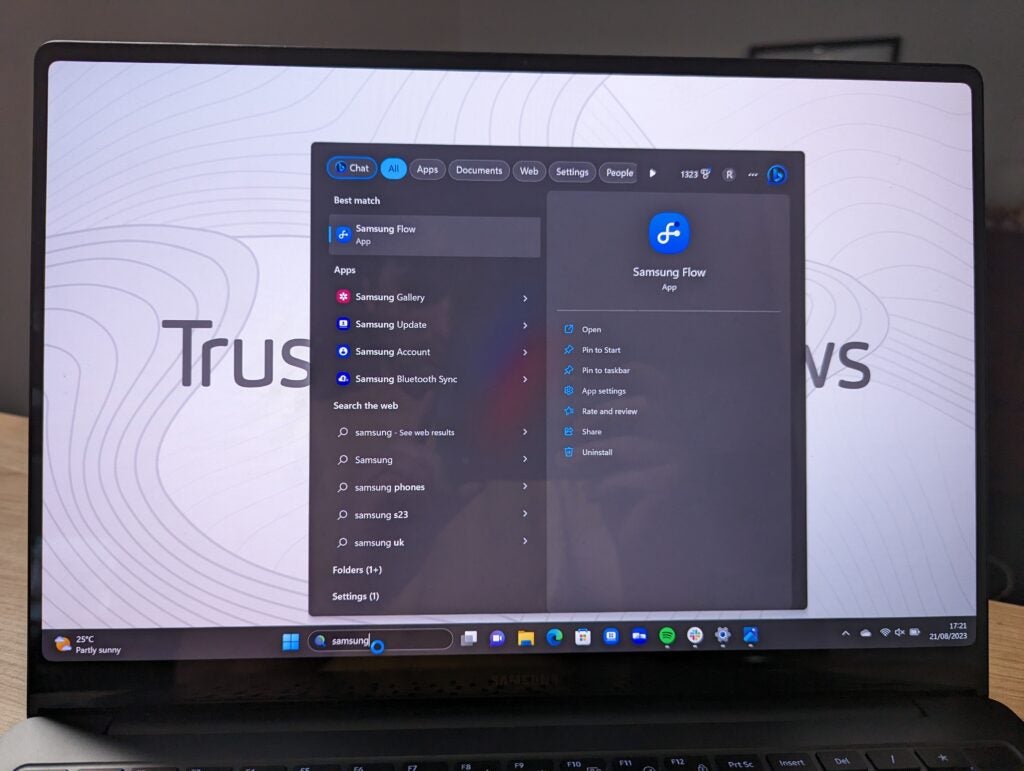
The Galaxy Book 3 Ultra also comes pre-installed with Samsung Gallery and Samsung Notes, syncing up with your smartphone automatically to ensure your photos, videos and shopping list are all accessible on both your laptop and smartphone.
The catch here is that these software features are only useful if you have a Samsung Galaxy smartphone – they’re wasted on someone like me who owns a Google Pixel 6. For those without a Samsung phone, all of these pre-installed Samsung apps feel like bloatware, taking up needless space. Fortunately, they are easy enough to uninstall.
Battery Life
- Battery lasts over 8 hours
- Takes 2 hours to recharge
Windows laptops with a discrete GPU usually stumble in battery tests, struggling to even surpass the 5-hour mark. Samsung has done a great job of balancing all the specs here to ensure lengthy stamina.
When running the PCMark 10 battery benchmark, which simulates day-to-day tasks until the cell is depleted, the Galaxy Book 3 Ultra lasted for 8 hours and 30 minutes. To emphasise just how good that result is, the Razer Blade 16 only managed 4 hours and 37 minutes in the same test, while the Asus Zenbook Pro 14 OLED achieved 7 hours and 59 minutes despite having a smaller 14-inch screen.
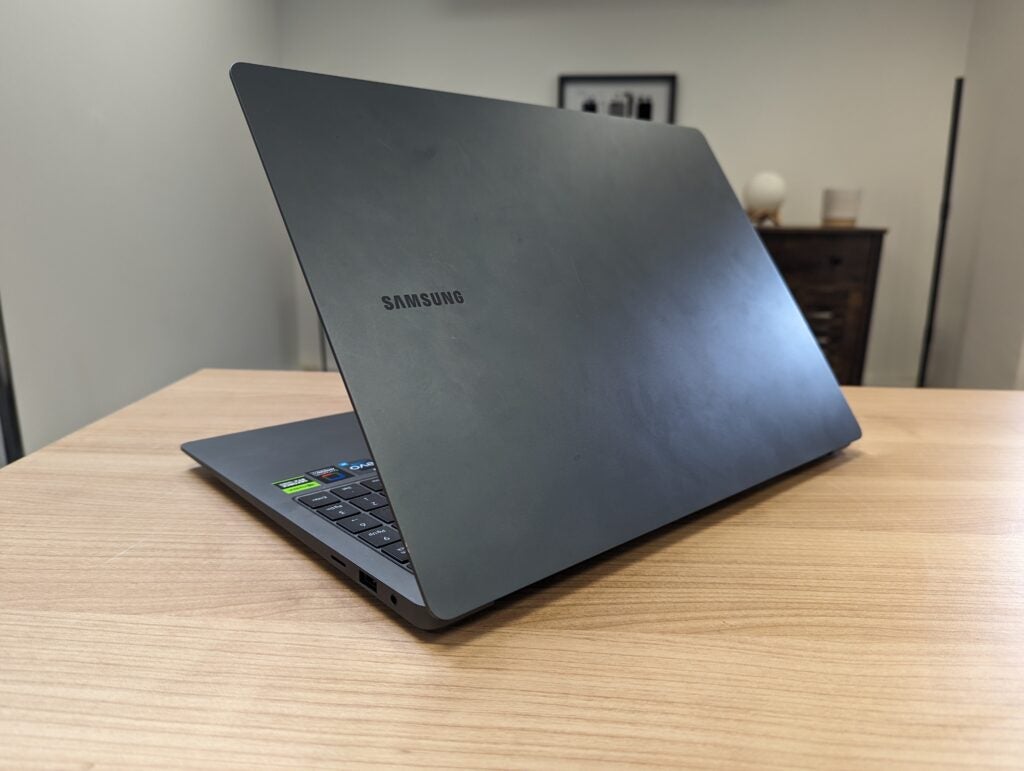
Apple remains the champion for battery life though, as my colleague could browse the web for close to 14 hours with the MacBook Pro before reaching out for the charger.
My testing shows that it takes roughly 2 hours to recharge the Samsung Galaxy Book 3 Ultra back up to 100%. Samsung bundles a 100W charger in the box, whereas Apple packs in a slightly more powerful 140W adapter with the MacBook Pro.
Latest deals
Should you buy it?
You want a portable machine for content creation
The Samsung Galaxy Book 3 Ultra is one of my top recommendations for content creation on the go, thanks to its careful balance between performance and portability.
You’re looking for the best value
The biggest issue with the Samsung Galaxy Book 3 Ultra is its steep price. There are more affordable options such as the Acer Swift Go 14 and MacBook Air for those that just need an entry-level graphics performance.
Final Thoughts
The Samsung Galaxy Book 3 Ultra is a fine choice for creators. The 3K screen provides excellent colour accuracy, the graphics performance is enough to tackle heavy workloads and it’s portable enough to take on your travels.
Is it good enough to thwart the MacBook Pro? Not quite. Apple’s laptop offers superior battery life, a marginally better performance and a more luxurious design. Nevertheless, the Galaxy Book 3 Ultra runs it close, and is one of the best attempts I’ve seen from a Windows laptop in the creativity market.
The high price is a problem, however, costing upwards of £3000/$3000 if you want the best specs for a high performance. The Asus Zenbook Pro 14 OLED represents better value and the Razer Blade 16 can be found with similar specs at a cheaper price. Check out our Best Laptop, Best MacBook Alternatives and Best Laptop for Video Editing lists for even more options.
How we test
Every laptop we review goes through a series of uniform checks designed to gauge key things, including build quality, performance, screen quality and battery life.
These include formal synthetic benchmarks and scripted tests, plus a series of real-world checks, such as how well it runs popular apps.
We use review machines as our main laptop for at least a week.
We test the performance via both benchmark tests and real-world use.
We test the screen with a colorimeter and real-world use.
We test the battery with a benchmark test and real-world use.
FAQs
No, it doesn’t have a touchscreen. If that’s a priority, check out the Samsung Galaxy Book 3 360 instead.
No, it lacks a touchscreen so a stylus is not supported.
If you’re a creator who needs a good graphics performance, but also a portable design, then this is a great alternative to the MacBook Pro.
Trusted Reviews test data
PCMark 10
PugetBench for Premiere Pro
Cinebench R23 multi core
Cinebench R23 single core
Geekbench 6 single core
Geekbench 6 multi core
3DMark Time Spy
CrystalDiskMark Read speed
CrystalDiskMark Write Speed
Brightness (SDR)
Black level
Contrast
White Visual Colour Temperature
sRGB
Adobe RGB
DCI-P3
PCMark Battery (office)
Battery recharge time








